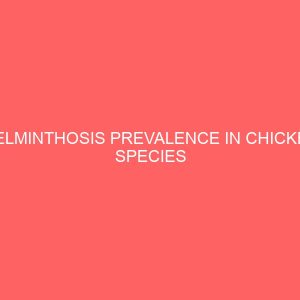Description
CHAPTER ONE
1.0 INTRODUCTION AND LITERATURE REVIEW
1.1 INTRODUCTION
This project is on Evaluation and identification of immuno-modulatory properties of prebiotics extracted from Vernonia amygdalina. Vernonia amygdalina, a member of the Asteraceae family, is a widely used local vegetable in Nigeria, Uganda and other African countries. It grows in a range of ecological zones in Africa and the Arabian Peninsula (Bonsi et al., 1995). The leaf is commonly called “bitter leaf” in English, “Olubu or Onugbo” in Igbo, “Ityuna” in Tiv, “Oriwo” in Edo, “Ewuro” in Yoruba, “Chusar-doki” in Hausa, “Etidot” in Efik, “Omubirizi” or “Omululuza” in West and Central Uganda; “Olusia” in Luo, Kenya. It is used in various food preparations and in ethnomedicine for the treatment of malaria and gastrointestinal infections. It is a shrub of 2-5 m tall with petiolate leaves of about 6.0mm wide (Ojiako and Nwanjo, 2006). It is up to 20 cm long and its bark is rough. The bitter taste of the leaf has been attributed to the presence of anti-nutritive principles like saponins, alkaloids, tannins and glycosides (Buttler and Bailey, 1973). There have been several reports on its antimicrobial, antiplasmodial, antitumor, antioxidant and antihelminthic properties (Jisaka et al., 1993; Izevbigie, 2003; Farombi, 2003; Ehiagbonare, 2007). Aqueous leaf extracts of V. amygdalina have been previously reported to have prebiotic properties (Ukwah and Ezeonu, 2008; Ezeonu and Ukwah, 2009; Ezeonu et al., 2012).
For many years, medicine depended exclusively on leaves, flowers and barks of plants, until the 1970s when synthetic drugs came into use (Conway, 1973). In orthodox medicine, a plant may be subjected to several chemical processes before its active ingredients are extracted, while in traditional medicine, a plant is simply eaten raw, cooked or infused in water or native wine or even prepared as food (Sofowora, 1992; Jones, 1996; Reynolds, 1996). Plant extracts are potential sources of novel antimicrobial compounds (Lis-Balchin and Deans, 1997) especially against bacterial pathogens, but it is necessary to investigate those plants scientifically which have been used in traditional medicine to improve the quality of healthcare. Plants extracts are usually composed of many phytochemical constituents. Prebiotics are non-digestible substances that when consumed provide a beneficial physiological effect on the host, by selectively stimulating the favourable growth or activity of a limited number of indigenous bacteria (Roberfroid, 2007; Mitchell, 2010). These prebiotic substances survive digestion in the stomach and reach the colon where they are metabolized by the bacteria, thereby directly providing the host with energy and metabolic substrates (Wang and Gibson, 1993; Cummings et al., 2001). Efficient prebiotics usually have a specific fermentation in the colon and have the ability to alter the faecal microflora composition towards a more beneficial community structure (Kolida et al., 2002; Chakraborti, 2011). Thus, prebiotics exert their beneficial effects on the host indirectly; by stimulating functions of the intestinal microflora.These include regulation of bowel function, modulation of gut immunity, inhibition of pathogens and anticarcinogenic properties.
In addition to these, prebiotics also have the advantage of relative ease of manufacture because they can be either directly extracted from natural sources or be produced by partial acid or enzymatic hydrolysis of polysaccharides or by transglycosylation reactions (Macfarlane et al., 2006; Falcao-e-Cunha et al., 2007).
The role of prebiotics in modulation of bowel function has been widely studied and reported (Gibson and Roberfroid, 1995; Hamilton-Miller, 2004; Lomax and Calder, 2009), but more recent studies have focused on their protective role against infections and diseases (Lomax and Calder, 2009; Chakraborti, 2011; Licht et al., 2011). The most widely studied prebiotics are inulin and non-digestible oligosaccharides such as oligofructose (Watzl et al., 2005; Leenen and Dieleman, 2007; Guarner, 2007; Lomax and Calder, 2009). These complex carbohydrates are non-digestible by the gastric juice, pancreatic and brush border enzymes and selectively stimulate the growth of intestinal microflora. These carbohydrates are commonly found in fruits, vegetables and plant products (Menne et al., 2000; Rastall et al., 2005). In the large intestine, prebiotics, in addition to their selective effects on intestinal bacteria, influence many aspects of bowel function through fermentation (Cummings et al., 2001). These substances are fermented by bacteria such as Bifidobacteria and Lactobacilli in the colon, to produce short chain fatty acids (SCFA) such as propionic, lactic, acetic, folic, and butyric acids. Hydrogen gas (H2) and Carbon dioxide (CO2) are also major products of prebiotic metabolism (Wang and Gibson, 1993; Cummings et al., 2001; De Vuyst et al., 2005; Saulnier et al., 2007). Besides the stimulation of intestinal bacteria, fermentability is an important property for evaluating or screening potential prebiotics, according to Cummings et al (Cummings et al., 2001). However, recent studies show that there may be other candidate-prebiotics such as xylitol, sorbitol, mannitol and lactulose (Chakraborti, 2011).
Pharmaceutical and nutritional industries are exploring more natural treatments for health conscious consumers as natural treatments have been effective since immemorial and are staging a comeback and natural ‘renaissance’ is happening all over the globe. The emerging area of prebiotics points towards the holistic role of nature in the health and nutrition of human beings.
1.1.1 Statement of problem
Prebiotics have recently come into use as an alternative to probiotics. While probiotics are meant to bring beneficial microorganisms to the gut, prebiotics selectively stimulate the beneficial microorganisms that already live there hence there is no risk of introduction of foreign microbial species into the gut. The use of probiotics has been faced with a serious problem of consumer confidence because many individuals are skeptical about consuming live microorganisms, regardless of the propounded benefits. The interest evoked by prebiotics is to a great extent connected with the idea of functional food. The benefits resulting from consumption of prebiotics foods are reported to include health and conditions improvement and reduction of risk of developing illnesses such as colon cancer and hypertension. Some of the prebiotic potentials of V. amygdalina have been reported previously.
1.1.2 Aim of the study
The aim of this study was to evaluate the immuno-modulatory properties of prebiotics extracted from Vernonia amygdalina.
1.1.3 Objectives of the study
To identify the prebiotic compounds in the plant.
To identify the active fractions of Vernonia amygdalina.
To evaluate the effect of oral administration of the extract on blood profile.
To evaluate the effect of oral administration of the extract on T-cell populations.
To evaluate the effect of oral administration of the extract on lipid profile.
1.2 LITERATURE REVIEW
1.2.1 History of Prebiotics
The term “Prebiotic” was coined in 1995 by Gibson and Roberfroid (Gibson and Roberfroid,1995), although prebiotics were recognized as early as the 1950s when György and coworkers described “bifidus factor”, a bifidogenic substance that selectively promoted the growth of bifidobacteria (called Lactobacillus bifidus at that time) (György et al., 1953; György et al., 1954). Human milk and colostrum were found to contain large amounts of “bifidus factor”. Multiple substances in human milk were found to be bifidogenic and were shown to stimulate the growth of bifidobacteria when administered to bottle-fed infants (Gauhe et al., 1954; Petuely, 1957). In the 1970s and ’80s, Japanese investigators pioneered the use of digestion-resistant saccharides to favorably modify the intestinal microbiota using fructooligosaccharides, galactooligosaccharides, and lactulose (Yazawa et al., 1978; Minami et al., 1983). Prebiotics offer the ability to enhance the healthful strains of bacteria including beneficial strains not available as probiotics, such as Eubacterium species (Louis et al., 2007).
1.2.2 Types of Prebiotics
Most prebiotics are used as food ingredients-in biscuits, cereals, chocolate, spreads, and dairy products, for example. Commonly known prebiotics are: Oligofructose, Inulin, Galacto-oligosaccharides, Lactulose and Breast milk oligosaccharides. Lactulose is a synthetic disaccharide used as a drug for the treatment of constipation and hepatic encephalopathy. The prebiotic oligofructose is found naturally in many foods, such as wheat, onions, bananas, honey, garlic, and leeks. Oligofructose can also be isolated from chicory root or synthesized enzymatically from sucrose. Fermentation of oligofructose in the colon results in a large number of physiologic effects, including:
- Increasing the numbers of bifidobacteria in the colon
- Increasing calcium absorption
- Increasing fecal weight
- Shortening gastrointestinal transit time
- Possibly, lowering blood lipid levels
The increase in colonic bifidobacteria has been assumed to benefit human health by producing compounds to inhibit potential pathogens, by reducing blood ammonia levels, and by producing vitamins and digestive enzymes.
1.2.3 Major Prebiotics and their characteristics
Prebiotics can be classified as a type of digestion-resistant carbohydrate or dietary fiber (De Vries, 2003; Warrand, 2006). Like all fibers, prebiotics resist breakdown by human digestive secretions and arrive relatively unchanged in the lower regions of the intestinal tract where they can be utilized as an energy source by the resident microflora. What distinguishes prebiotics from other fibers is that prebiotics by definition selectively stimulate the growth of only beneficial microfloral organisms such as lactobacilli and bifidobacteria. Prebiotic properties have been ascribed to many types of carbohydrates, but they have been best documented for digestion-resistant oligosaccharides (DGOs) (Gibson and Roberfroid, 1995; Tuohy et al., 2005). Phytochemical analysis of some prebiotics have been reported to contain some constituents such as Carbohydrates, and oil, reducing sugars, steroids, saponins, and tannins. Saponins are complex glycosides made up of sugar (glycone) and non-sugar (aglycone) groups. The glycone can consist of a single group of sugars (monosaccharides) or several groups of sugars (oligosaccharides) (LASCU, 2008). The foaming characteristic usually observed with saponins is caused by the combination of the non-polar aglycone and the water soluble side chain (glycone) and on contact with water, the sugar group dissolves releasing the non-sugar group (Ajali, 2004; LASCU, 2008; Shi et al, 2004). Saponins have been reported to have biological activities including anti-inflammatory, anticancer, immune stimulating, antimicrobial and anti-plasmodial properties (Philipson et al., 1993; Farombi, 2003; Ajali, 2004; Ray, 2007). In addition, saponins are believed to be non-systemic and able to escape digestion in the upper gut to arrive in the colon (Ajali, 2004). This latter property is an important property of all prebiotics. Some carbohydrates are also known to escape digestion to arrive in the intestine where they are fermented by microflora. These include inulin (a vegetable carbohydrate), fructo-oligosaccharides, galacto-oligosaccharides and pectic oligosaccharides (Cummings et al, 2001; De Vuyst et al., 2005; Rastall et al., 2005; Menne et al., 2000; Saulnier, et al., 2007; Roberfroid et al., 1998; Bouhnik et al., 1999; Tannock et al., 2004).
DGOs include inulin-type fructans, galacto-oligosaccharides, lactulose, isomalto-oligo saccharides, xylo-oligosaccharides, soyoligosaccharides, gentio-oligosaccharides and nigeroligo saccharides 1. They may be found naturally occurring in foods or milk or they may be synthesized. Most DGOs are composed of 3 to 10 sugar moieties, although the number of linked sugar molecules (degree of polymerization) varies. Chicory inulin may have up to 60 linked fructose molecules while lactulose, a synthetic prebiotic, consists of only galactose linked with fructose (Roberfroid, 2005).
DGOs do not have uniform chain length, but are a mix of oligosaccharides with variable degrees of polymerization. They generally have glycosidic bonds in the βconfiguration and resist hydrolysis by human salivary and pancreatic digestive enzymes which are specific for αglycosidic bond 18. Ingested DGOs reach the colon largely intact where they are fermented by specific colonic microbial strains possessing a wide assortment of carbohydrolytic enzymes (Cummings et al., 2001). The rate of fermentation is strongly influenced by the constituent monomeric sugars, the degree of polymerization, type of linkage between monomeric units, and the general complexity of the molecule. Of the many forms of DGOs, only inulin-type fructans, galactooligo saccharides, and lactulose fully meet the criteria established for classification as prebiotics (Tuohy et al., 2002; Gibson et al., 2004).
Inulin-type Fructans
Inulin is arbitrarily defined as mixture oligosaccharides with chain lengths of 2-60 fructose molecules 24 with or without an initial glucose.Inulin-type fructans are storage carbohydrates commonly found in wheat, onions, asparagus, bananas, garlic, artichokes, and leeks (Van Loo et al., 1995).
Galactooligosaccharides-Galactooligosaccharides
Galactooligosaccharides are digestion-resistant oligosaccharides naturally found in both human and cow’s milk (Tuohy et al., 2005). They can also be derived from specific microbial fermentation of lactose or synthesized using the enzyme βgalactosidase and lactose syrup. Galactooligosaccharides selectively augment Bifidobacterium and Lactobacillus numbers within the human intestinal microbiota. Prebiotic applications of galactooligosaccharides are of great interest because of their natural occurrence in human milk.
Administration of galactooligosaccharides to formula fed infants has been shown to engender an intestinal flora similar to that of breast-fed infants Bifidobacteria populations are enhanced, pathogen numbers decrease; short-chain fatty acid production increases, fecal pH decreases, and stool characteristics such as frequency and consistency are improved. Galactooligosaccharides appear to offer well-documented prebiotic support, especially in infants, and are only now in the early stages of clinical acceptance.








Reviews
There are no reviews yet.